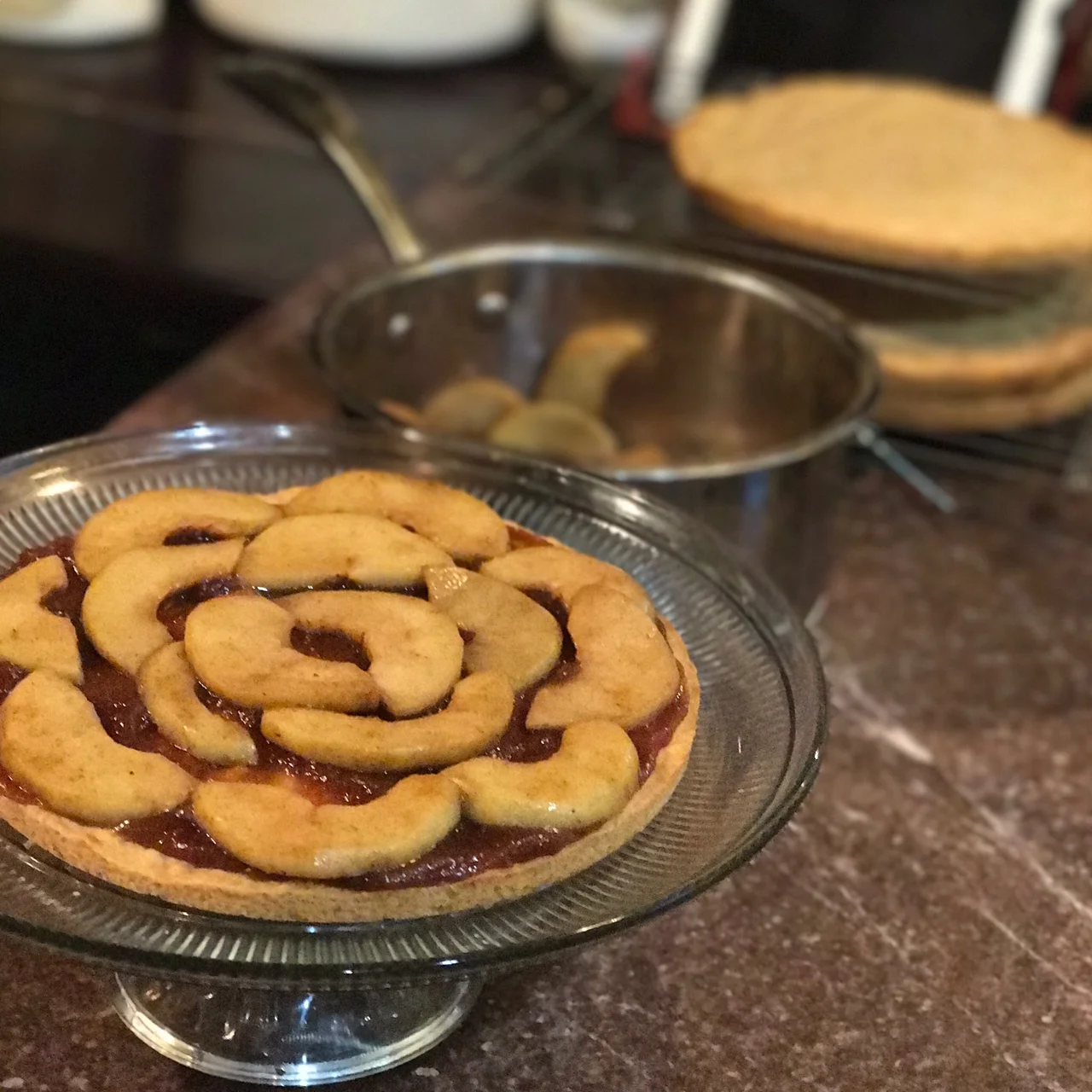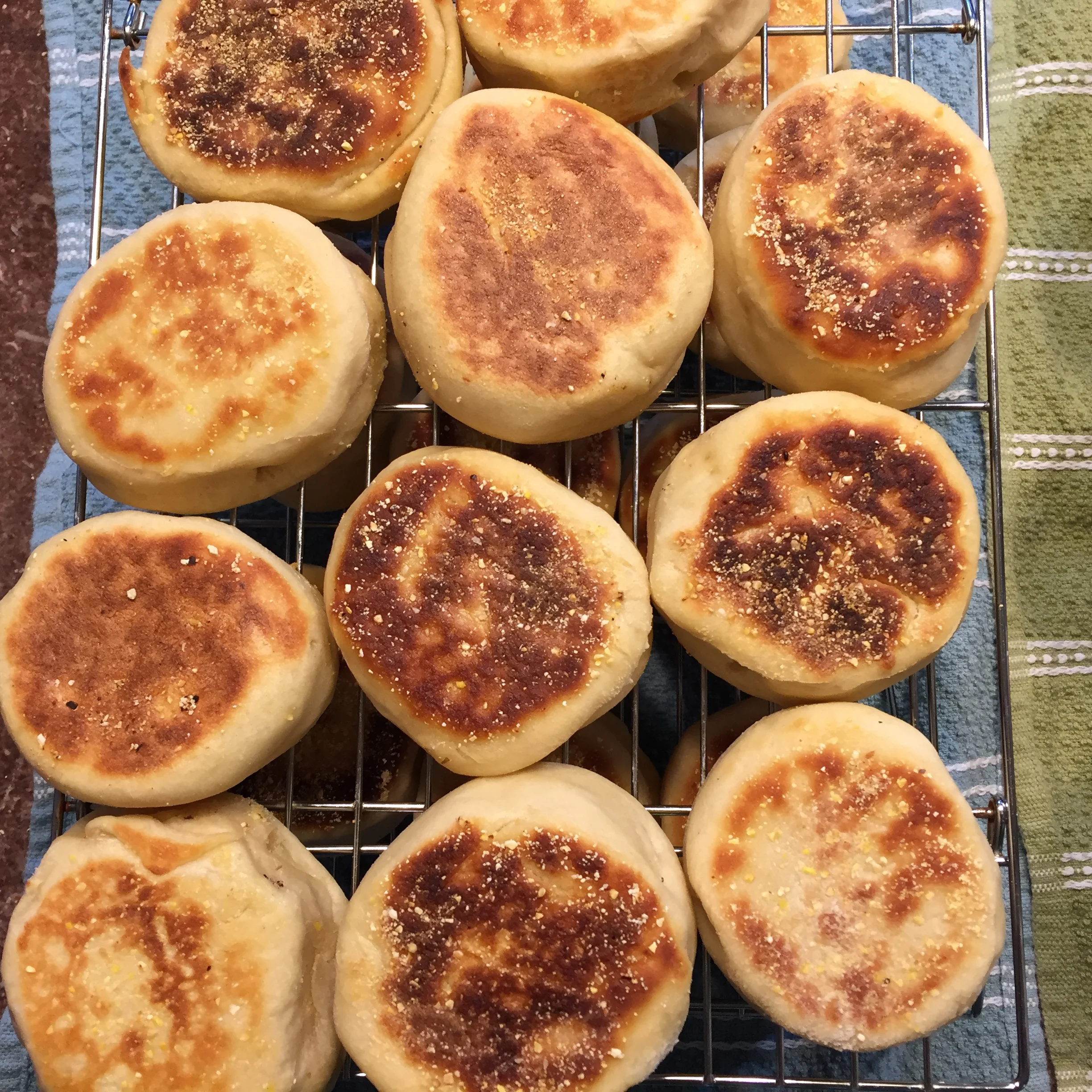This is our strawberry filling version!
Chocolate (Strawberry) Whoopie Pies!
You’ve heard of the song, “Makin’ Whoopie”? Well, I’m gonna share how to make some delicious Chocolate Whoopie pies with a filling that can be modified to your taste buds (or seasonal flavors)!! I must thank Martha Stewart for the base of this recipe; however, as with anything, we’ve put our Will Bake 4 Food twist on it ;).
Ingredients:
Wet:
1 C (2 sticks) butter, room temp (I almost always use salted, and it didn’t seem to matter in this case)
2 C granulated sugar (I know this is technically a “dry” ingredient)
2 C buttermilk, shaken, room temp
2 Grade A Large Eggs
2 t pure vanilla extract
Dry:
3 ½ C All-Purpose Flour
1 t salt
1 ½ C baking cocoa. (I like to use ½ C of Hershey’s Special Dark; because of the need for the puff reaction between the cocoa and baking soda, we can’t replace the entire cocoa mixture with the Dutch processed cocoa.)
1 T baking soda
1 t baking powder
Filling:
¾ C granulated sugar
1/3 C water
1 T light corn syrup
3 large egg whites
1 T granulated sugar
½ t vanilla extract
1 t of an extract of your choice (this is DELICIOUS with a strawberry extract).
Other things you’ll need:
Handheld, with beater attachment or Stand mixer with both beater and whisk
Large bowl
2 baking sheets
Parchment paper or silpats
Small (1-2 oz) ice cream or cookie scoop
Heavy bottomed sauce pot
Candy thermometer
Piping bag and favorite tip for frosting
Instructions:
Let all of your wet ingredients come up to room temp; depending on your house temp, this could take 20-60 minutes. Preheat the oven to 400degF and place wracks in middle and lower third.
Prepare your dry ingredients: In a large bowl, whisk together the flour, salt, cocoa, baking soda and baking powder. Set this mixture aside.
Line two standard baking sheets with parchment paper or non-stick mat and set aside.
In the bowl of a stand mixer fitted with the paddle attachment OR with a hand mixer with the beaters, break up your butter a bit until smooth. Add the sugar and cream with the butter until light and fluffy (about 2 minutes). Lightly beat the vanilla in the eggs and add to the butter mixture.
Next, I add the dry mixture and buttermilk by starting with 1/3 of the dry, then ½ of the buttermilk, repeat and end with the final 1/3 of the dry mixture. This dough is THICK (cocoa absorbs a LOT of moisture!)
With an ice cream or cookie scoop that’s about 1 oz. size, drop mounds no less than 2 inches apart onto your prepared cookies sheets. Bake for about 10-12 minutes. I like to finish one pan, put it in the oven on the top of my two shelves (middle of the oven); set the timer for 5 minutes; prepare the second pan and after that 5 minutes is over, move the pan in the oven to the bottom shelf and add the cold pan to top shelf. You’ve created a cookie factory! This rotation helps the cookies to cook evenly and spaces out the timing to allow for this rotation for all your batter. Also, you will never forget which pan was in first! If it’s on the bottom, it’s done when the timer beeps! Because the batter is so dark, it’s hard to tell when they’re “done.” You can insert a tester/toothpick in the center of a couple of the mounds, and if it comes out clean, you’re good to go. You might have to add a minute to the pans, but it’s not hard to keep track. When putting the pan onto the bottom shelf, always set time to 5 minutes and rotate, they’ll be great! Once baked, remove and let cool completely on a wire rack.
The shells on the right have been piped, and the left have been scooped. . . they BOTH work, but end up a bit "fluffier" with the scoop.
***Depending on your size needs, you can make these as big or small as you’d like, but you’ll have to adjust your bake time accordingly. We tried piping the batter, and though they were nearly as good, they stayed a little denser across the board when piped. If you’re going for a smaller cookie size, piping is WAY easier to get consistent size/shape. ***
After the last pan is on its last 5 minutes of the rotation, you can start to begin the frosting! This recipe of frosting makes a little too much, but I just made some meringue cookies with the remaining frosting (what I didn’t eat. . . ).
For the frosting:
Separate your eggs, don’t throw away the yolks! Make a fruit curd out of them! Place the sugar, water and corn syrup into a medium-sized, heavy bottomed pot. On medium heat, let the sugar start to dissolve, swirling occasionally. When the liquid is clear, you can increase the heat slightly and slip in your candy thermometer. When your thermometer reaches about 200-205 DegF, in a stand mixer fitted with the whisk attachment, start to whisk your egg whites until soft peaks form (I almost ALWAYS use a pinch of cream of tartar, but it’s not required here). Add the reserved tablespoon of sugar and whisk until your start to get stiff peaks. The timing here should work out perfectly, but if you’re not to temp with the sugar mixture, just turn off your mixer once your eggs are at nearly stiff peaks.
When your sugar mixture reaches “Soft Ball” stage or 240 degF, pull it off the heat, and with your mixer on “stir,” slowly drizzle the sugar mixture down the side of the bowl into the whites. Once it’s all in, increase your speed to Medium-High and let beat for about 7 minutes or until the bowl is cool to the touch.
Congratulations, you’ve now succeeded in the basic technique for an Italian Meringue! Here’s the “seasonal” part! After you get the meringue frosting to the bowl’s being cool, you can add a ½ teaspoon of vanilla and then 1 teaspoon of whatever flavor you’d like. Peppermint is great; I used strawberry, so that it was a bit like a “chocolate covered strawberry”! It’s possible to color the meringue, BUT you can’t use a gel coloring (ask me how I know!) as any oil will deflate the meringue; you’d have to stick with a powder coloring. An extract with color, will give the glossy white frosting a slight hue of the extract put into it.
Once your frosting is complete, scoop the mixture into a piping bag prepared with your favorite tip. Flip ½ of the shells over and pipe onto the flat sides and then cover with the other half of the shells. OR you can scoop the frosting in between two shells (about 2 T per sandwich)!
Either way? You’ve succeeded at “Makin’ Whoopie”!! ;) Check out Track 7 below!!

















